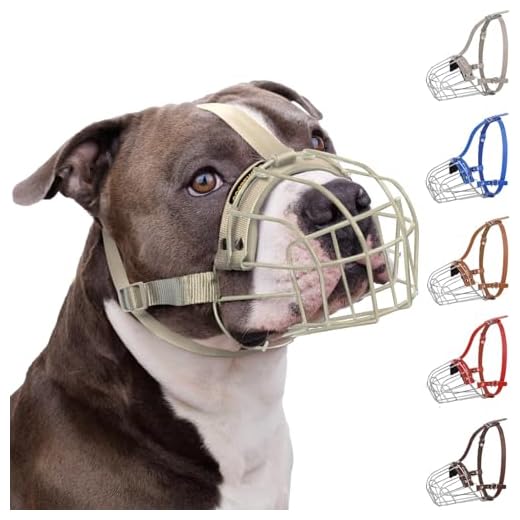




Using a restraint designed for canines can be a responsible choice when safety is a priority. Many pet owners find themselves in situations where these devices provide a sense of security for both their pets and those around them. However, it’s crucial to approach this practice with knowledge and care to ensure it benefits your furry friend rather than causing stress or discomfort.
Understanding the specific needs of each breed is essential. Certain breeds may require these devices due to their temperament or behavior, particularly in crowded or unfamiliar environments. It’s advisable to choose a restraint that allows for comfortable breathing and does not restrict movement excessively. This ensures that the experience remains positive rather than traumatic for your companion.
Additionally, training plays a significant role in how well a canine adjusts to wearing such devices. Gradual introduction, positive reinforcement, and associating the experience with enjoyable activities can help alleviate anxiety. Sharing personal experiences, I recall how my own pet initially resisted wearing a restraint but, with patience and treats, learned to accept it as a normal part of our outings.
Before deciding on its use, consult with a veterinarian or a professional trainer to evaluate whether this option is suitable for your companion’s specific circumstances. Their insights can help determine the best approach, ensuring that your pet feels secure and loved while navigating the world.
Understanding the Purpose of Canine Restraints
Using a restraint can enhance safety in various scenarios. These devices can be beneficial during visits to the vet or groomer, where unfamiliar environments may cause anxiety. They can help prevent accidental bites when a pet feels threatened or is in pain.
These tools are also helpful during training sessions. They can assist in managing certain behaviours, allowing for a more controlled environment while teaching new commands. By reducing distractions or potential triggers, the focus can shift to learning and interaction.
Promoting Positive Experiences
It’s important to select the right type of restraint that prioritises comfort. A well-fitted option can allow for secure mouth movement without causing distress. This not only builds trust but can also contribute to positive associations with wearing the restraint. Gradual introduction, along with rewards, can ease the transition and reduce any apprehension.
Addressing Misconceptions
There’s often a misconception that these devices are solely for aggressive animals. In reality, many calm companions may benefit from wearing them in specific situations. Understanding the purpose behind these tools can shift the perspective from seeing them as punishment to viewing them as a helpful measure for various circumstances.
When is it Appropriate to Use a Muzzle?
Utilising a restraint for a canine is appropriate in specific situations. For instance, during veterinary visits, when a pet is anxious or in pain, a restraint can prevent sudden movements or bites. This ensures the safety of both the animal and the staff. Additionally, it can be beneficial in crowded places where the risk of overstimulation or aggression increases. A well-fitted restraint can help reduce anxiety and help the canine feel more secure.
Training and Behavioural Issues
In cases where a canine exhibits aggressive behaviour or has a history of biting, a restraint can be a temporary solution while working with a trainer. It’s a tool for managing behaviour during rehabilitation. It’s crucial to pair the use of a restraint with positive reinforcement training methods to address the underlying issues. Always ensure that the canine is comfortable and accustomed to the restraint before using it in public settings.
Safety During Travel
Traveling can be stressful for many canines. Using a restraint in a car can protect the pet from harm during sudden stops or accidents. Additionally, if you’re taking your pet on public transport, a restraint can help alleviate the stress of travelling in a confined space. It’s advisable to ensure the pet is familiar with the restraint prior to travel, making the experience smoother for both of you.
For those looking to enhance their pet’s diet, I recommend checking out the best dry dog food for great dane puppy. Nutrition plays a significant role in overall behaviour and health, which can indirectly influence how a canine reacts in various situations.
Choosing the Right Type of Muzzle for Your Canine
For optimal comfort and safety, select a basket style for long-term wear, especially if frequent outings are on the agenda. This design allows for panting and drinking while still providing restraint. For short visits to the vet or grooming sessions, a fabric option might suffice, as it can be easier to fit and remove quickly.
Size is critical. Measure the snout’s length and circumference accurately. A snug fit prevents slipping but should not constrict movement. Adjustability can enhance comfort, ensuring that the fit is secure without causing distress.
Material choice plays a role in durability and comfort. Leather offers a robust option for active canines, while nylon can be lightweight and easier to clean. Ensure that any material used is non-irritating to the skin, especially for sensitive breeds.
Consider the temperament of the furry companion. A more anxious creature may benefit from a soft option that doesn’t feel too restrictive. Conversely, a confident or assertive individual might require a sturdier model to prevent any unintended consequences during interactions.
Lastly, introduce the chosen restraint gradually. Allow the animal to explore it in a familiar environment, rewarding them with treats or praise. This positive reinforcement can ease any apprehension, ensuring a better experience for both of you.
How to Train Your Dog to Accept a Muzzle
Start by associating the muzzle with positive experiences. Choose a time when your canine companion is calm. Hold the muzzle in one hand and a treat in the other. Allow them to sniff the muzzle without forcing it. Praise them for their curiosity.
Gradually introduce the muzzle closer to their face. Reward them for each step they take towards acceptance. If they show signs of discomfort, slow down and give them time. Patience is key.
Once they are comfortable with the muzzle near their face, place it gently on their snout for a few seconds, securing it loosely. Offer a treat immediately. Gradually increase the duration they wear it, always pairing it with rewards and praise.
Practice this in short sessions, keeping it positive and stress-free. If your furry friend resists, return to earlier steps. Consistency will help them adjust.
Once they can comfortably wear the muzzle for extended periods, practice wearing it during walks or in environments where they might feel anxious. Continue to reward good behaviour, reinforcing the idea that the muzzle is a normal and non-threatening item.
Over time, your pet will learn that wearing the muzzle is just another part of their routine, and they can enjoy outings without stress. Building trust through this process is essential for a smooth transition.
Common Misconceptions About Muzzles and Dog Behaviour
Many believe that a restraint signifies aggression or a lack of training. This is misleading. In reality, many breeds require it for safety during specific situations, such as vet visits or grooming sessions. It’s a tool for protection, not a sign of poor behaviour.
Misunderstanding the Purpose
- Some assume that wearing a restraint inhibits their companion from breathing or panting. However, well-designed options allow for comfort and natural behaviour.
- Another myth is that a canine will feel humiliated or ashamed while wearing one. In truth, it’s merely an accessory for certain scenarios and can be introduced positively.
- Many people think it’s only for aggressive individuals. Actually, it’s beneficial for anxious or fearful animals as well, providing them with security in stressful situations.
Social Stigma
There’s a prevailing thought that using a restraint labels a companion as dangerous. This stigma can discourage guardians from using one, even when it’s necessary. Conversations with professionals can help change this perception. It’s important to communicate that a restraint is just one part of responsible guardianship.
- Ask trainers for advice on selecting the right type for specific needs.
- Share experiences with fellow guardians to normalise the use of a restraint in everyday life.
- Educate others about the varying situations where it can be beneficial, such as during travel or in crowded areas.
Understanding these misconceptions allows for a more informed approach, ensuring that each companion can navigate the world with confidence and safety.
FAQ:
Is it harmful to use a muzzle on my dog?
Using a muzzle can be beneficial in certain situations, but it is crucial to choose the right type and fit for your dog. Muzzles are not inherently harmful; they can prevent biting and help keep both your pet and others safe. However, if a muzzle is too tight or used for extended periods, it can cause discomfort or distress. Always ensure that the muzzle allows your dog to breathe comfortably and pant, and introduce it gradually to help them adjust.
What are the reasons for muzzling a dog?
Muzzling a dog may be necessary for several reasons. For instance, it can be used during visits to the vet or groomer, particularly if the dog is anxious or prone to biting. Muzzles can also be helpful in situations where a dog may encounter unfamiliar people or other animals. Additionally, some owners may use muzzles to prevent their dogs from eating harmful objects during walks. In all cases, it is important to train your dog to accept the muzzle positively and to use it responsibly.
How can I train my dog to wear a muzzle?
Training your dog to wear a muzzle should be a gradual process. Start by letting your dog see and sniff the muzzle, rewarding them with treats for curiosity. Next, you can place the muzzle on their snout without fastening it, ensuring they remain calm. Gradually increase the time they wear it, rewarding them with praise and treats. Once they are comfortable, you can secure the muzzle for short periods, progressively extending the duration. Always monitor your dog’s comfort and provide breaks as needed.
Are there specific types of muzzles that are better for different breeds?
Yes, the type of muzzle you choose can depend on your dog’s breed, size, and behaviour. Basket muzzles are often recommended for larger breeds as they allow for panting and drinking, making them suitable for longer wear. Soft muzzles can be better for smaller breeds or short-term use, but they may not offer the same level of ventilation. It’s essential to consider your dog’s specific needs and consult with a vet or dog trainer for recommendations tailored to your pet.








